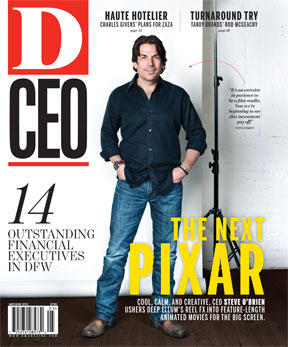Management, Ed Whitacre says, is 95 percent about people.
“If you can get that part right—the people part—most times the other stuff will work itself out,” says the plain-spoken Texan. He ought to know. For nearly two decades, the Ennis native successfully ran two of the country’s biggest companies: SBC Communications, now Dallas-based AT&T Corp., and General Motors.
When Whitacre was lured out of retirement by the Obama administration in 2009 to take over as GM’s chairman following a bankruptcy filing and $50 billion federal bailout, he didn’t know a thing about the auto business. But he knew plenty about managing people. So like a baseball coach during spring training, he set about assessing his team. His experience, detailed in his new book American Turnaround, may surprise you. It did me.
The main problem at GM, Whitacre concluded, wasn’t high-priced union contracts with the United Auto Workers—a common whipping boy for U.S. auto industry woes.
Rather, he says, management over many years had run the company into the ditch.
Whitacre found GM’s top executives unfocused. The management team was organized into a matrix, meaning most reported to more than one person. That, says Whitacre, left most of them unaccountable.
“You could ask people, ‘What’s going on?’ and they couldn’t tell you, or ‘What went wrong?’ and they couldn’t tell you,” he told me in a recent telephone interview from his home in San Antonio.
“It’s just incredible. It was just a management thing that caused all that to happen, in my opinion.”
Such candor is refreshing. Unions often get the blame when big companies hit the skids. To be sure, high labor costs can present a huge obstacle to success in the global business world. But it’s management’s job to deal with it.
Consider American Airlines. The Fort Worth-based carrier blamed high labor costs as a primary cause of its Chapter 11 bankruptcy filing. True, most of its competitors had already cut wage and pension costs in bankruptcy court, leaving American’s cost structure out of whack. But it’s also true that the airline’s executives were unable to negotiate cost-cutting contracts with their unions—for more than five years.
That’s a management failure.
Whitacre, now 71, views the CEO’s role as a change agent, not a caretaker. Over 17 years at the helm of SBC and AT&T, he acted boldly, taking the smallest of the “Baby Bells” and transforming it into the nation’s leading telecommunications firm by spending billions to buy companies including Pacific Telesis, BellSouth, and AT&T.
His most important move may have been one of his first as CEO—relocating SBC’s headquarters from St. Louis to San Antonio. Whitacre, who had spent his whole career at Southwestern Bell, was all too familiar with its corporate culture: dull, plodding, entrenched. (Those are his words.)
“Things needed stirring up,” he wrote.
He picked Texas, home to 60 percent of its revenue and customers. And he chose San Antonio over Dallas because it had fewer corporate headquarters (“I figured we’d be special there”) and Dallas had “horrific traffic.” (His successor, Randall Stephenson, obviously thought otherwise. After Whitacre retired, he moved AT&T to Dallas.)
At GM, Whitacre arrived as an outsider, so he could size people up with no deference to the past. He started with Fritz Henderson, a GM lifer appointed CEO several months before Whitacre arrived. His gut quickly told him that Henderson wasn’t up to the task; within months, he was given the boot.
At the board’s urging, Whitacre took over as CEO. He moved to simplify the management matrix and break down old walls. He regularly left the corporate suite to visit employees unannounced at GM’s engineering center, in the company cafeteria, even at Solidarity House, the UAW headquarters. While reaching out to union chiefs raised eyebrows at GM headquarters, it came naturally to the son of a railroad worker.
“I don’t have anything against unions. I grew up in a union family,” Whitacre said. “I had a great relationship with the UAW. They were very helpful to me.”
GM recovered. Profits returned the following year and in November 2010, the company raised more than $20 billion in a stock offering. Whitacre announced his departure just 14 months after arriving in Detroit. The automaker’s recovery is playing out in Arlington, where its huge SUV plant is undergoing a $530 million expansion, adding a stamping plant and 1,000 new workers.
The product of a people person.






